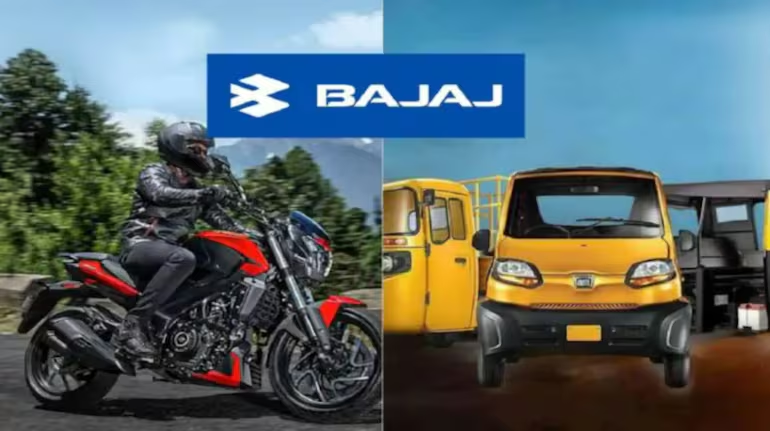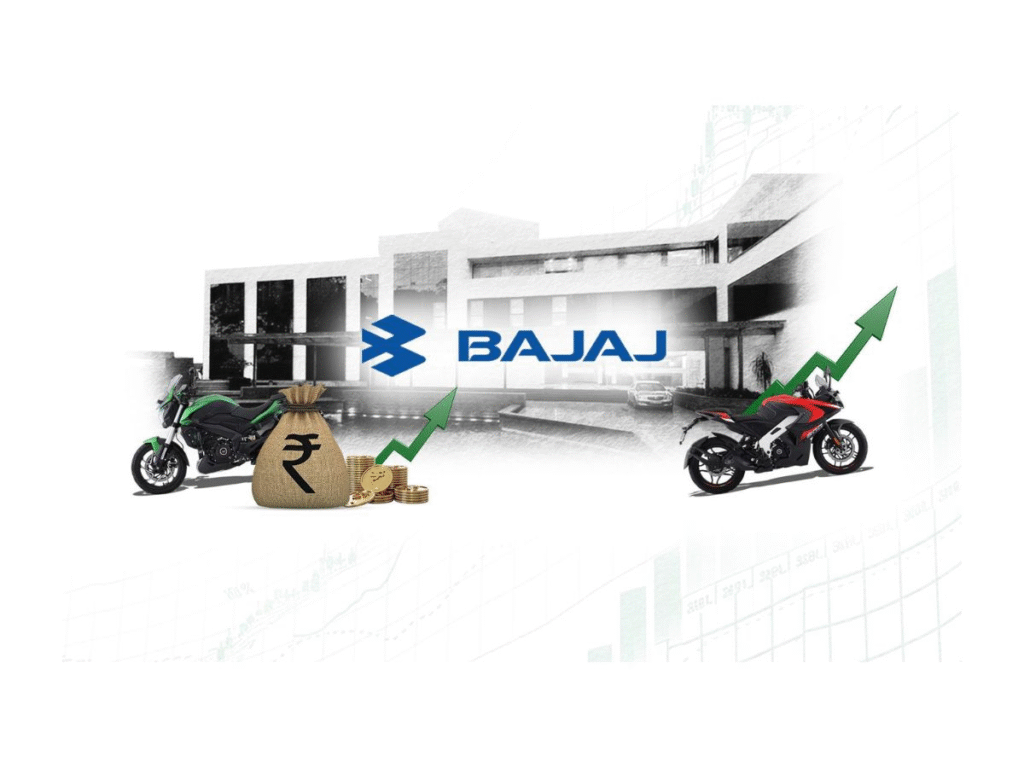Bajaj Auto Q1 FY26 results show a 14% jump in profit driven by strong premium bike sales, electric vehicle demand, and all-time high exports.
If you’ve recently seen more sleek KTM bikes zipping by or shiny Chetaks gliding silently through traffic, you’ve likely witnessed Bajaj Auto’s silent transformation in motion. The Q1 FY26 results are out, and they aren’t just numbers — they’re proof of a strategy that’s starting to pay off in bold, high-octane ways.

With a 14% rise in profit and over ₹13,000 crore in revenue, Bajaj Auto’s Q1 performance is a masterclass in how to mix legacy, innovation, and timing in India’s ever-evolving mobility market.
Let’s break down how they pulled it off — and what it means for Indian auto lovers, investors, and the EV-curious crowd.
💥 Bajaj Auto’s Q1 FY26 Highlights at a Glance
- 🔼 PAT (Profit After Tax): ₹2,210 crore — up 14% YoY
- 🔼 Revenue from operations: ₹13,133 crore — up 10% YoY
- ⚙️ EBITDA: ₹2,500 crore approx. | Margin at 19.7%
- 💰 Free cash flow added: ₹1,200 crore
- 🌍 Exports: All-time high, consistent double-digit growth
- 🚀 Electric vehicle revenue: Now >20% of domestic business
- 🛵 Chetak EV volumes doubled YoY
- 🏍️ KTM + Triumph: 25,000+ bikes sold domestically
🔑 Premium Motorcycles: The ₹8,000+ Bike That Sold Like Hot Idlis
🔥 A Rising Appetite for Power + Prestige
Gone are the days when most Indian bikers settled for 100cc commuters. Today’s buyers want torque, tech, and brand appeal — and Bajaj has delivered with its 125cc+ segment leading the charge.
The KTM Enduro R and Triumph Scrambler 400X emerged as runaway hits, helping Bajaj bill over 25,000 premium motorcycles in the domestic market, marking a 20% YoY growth.
Why it worked:
- Strategic refresh of popular models
- Smart pricing in aspirational mid-range (₹2–4 lakh)
- Youth-focused marketing in Tier 1 & 2 cities
- “Make in India” value with global styling
🧠 What You Should Remember:
Premium isn’t just about pricing. Bajaj cracked the sweet spot where performance, prestige, and practicality overlap — and it’s paying dividends.
⚡ Electric Vehicles: Chetak’s Comeback Turns Into a Power Play
🔋 Chetak Is No Longer Nostalgia — It’s Market Muscle
Bajaj’s electric scooter brand, Chetak, more than doubled its retail volumes YoY. Even more impressively, it accounted for nearly 50% of the entire industry’s incremental EV two-wheeler volumes in India.
The newly launched Chetak 2903, positioned as an affordable, value-packed variant, boosted reach into 750 cities, making it a key driver of EV revenue, which now accounts for over 20% of Bajaj’s domestic business.
Key Factors Behind the Surge:
- Expanded distribution network
- Supply chain improvements for rare earth magnets
- Affordable, stylish EV offerings under ₹1.2 lakh
- Rising fuel prices pushing EV demand
🧠 What You Should Remember:
Chetak isn’t just a sentiment play anymore. It’s a core growth engine, delivering volumes, margins, and goodwill in the fast-growing EV race.
🌍 Exports: Africa, LATAM, and Asia Fuel Global Momentum
🌐 From Pune to Peru: How Bajaj Went Global Quietly
While most headlines focus on domestic performance, Bajaj Auto’s export revenues hit an all-time high, with double-digit growth in six of the last seven quarters. Africa, Latin America, and Asia were key contributors — even as the MENA region saw weakness due to geopolitical instability.
Even more significantly, the resumption of exports to KTM (post-restructuring) added fresh momentum to the company’s international push.
Global Growth Drivers:
- Affordable models with rugged reliability
- Strategic tie-ups with local distributors
- Resilient supply chain and product customization
- Bajaj’s strong after-sales and service footprint abroad
🧠 What You Should Remember:
Bajaj isn’t just India’s auto story anymore — it’s quietly becoming a major export success in the emerging world’s mobility scene.
🚛 Commercial Vehicles: Holding Ground with Steady Strength
🚐 e3W Segment Powers Ahead
Bajaj Auto has now clocked 1 lakh+ retail commercial vehicle sales for eight consecutive quarters, with the electric 3-wheeler (e3W) category becoming the new dark horse.
The company’s L5 category e3W volumes grew nearly 3x YoY, pushing market share up by a massive 1000 basis points to 36%.
What’s Driving This Commercial Surge?
- Last-mile delivery and intra-city cargo demand
- Increased adoption of e3Ws in logistics and public transport
- Government subsidies and faster EV registration
- Dominance in the L5 segment with a cost-efficient lineup
🧠 What You Should Remember:
While bikes steal the limelight, Bajaj’s consistent play in the CV segment adds stable, recurring revenue — a moat few see.
📊 Financial Discipline: Margin Pressure Offset by Product Mix & Cash Flow Smarts

💼 Managing Margins in a Volatile World
Even with dollar realisations impacting EBITDA margins (down by 50 bps QoQ to 19.7%), Bajaj Auto managed to hold strong, thanks to:
- A smarter product mix (more premium, fewer discounts)
- Operating leverage from volume scale
- Tight control on commodity costs
- Strong free cash flow: ₹1,200 crore added this quarter
The company also:
- Maintained a surplus of ₹16,726 crore
- Invested ₹300 crore into Bajaj Auto Credit
- Infused ₹1,525 crore into Bajaj Auto International Holdings BV for KTM Austria
🧠 What You Should Remember:
When inflation hits and global shocks ripple, only companies with tight cash flow discipline and smart hedging survive — Bajaj Auto clearly belongs to that elite club.
📉 What Didn’t Go As Planned?
While the overall quarter was robust, a few areas showed challenges:
- EBITDA margin pressure from weak forex realisations
- MENA region exports remained muted
- The stock traded flat post-results despite strong performance — showing cautious investor sentiment
But these weren’t red flags — more like yellow signals that Bajaj will likely address in future quarters.
🏁 Final Thoughts: Bajaj Auto’s Strategic Recalibration Is Paying Off
What makes this quarter so impressive isn’t just the ₹2,210 crore profit. It’s how Bajaj Auto achieved it — with smart bets on EVs, a return to premium bike glory, export agility, and financial prudence.
For Indian investors and auto enthusiasts, this isn’t just a corporate success story — it’s a sign of where India’s mobility future is heading.
📣 Call to Action
Are you seeing more EVs and premium bikes in your city too?
What’s your take — would you pick a Chetak over an Activa or a KTM over a Royal Enfield?
Share your thoughts in the comments — and don’t forget to follow for more smart breakdowns of the business moves shaping India.

Which premium bike brands boosted sales?
KTM and Triumph, especially Enduro R and Scrambler 400X.
What was Bajaj Auto’s Q1 FY26 profit?
₹2,210 crore — a 14% YoY increase.
How did Chetak perform in Q1 FY26?
Retail volumes doubled YoY, contributing nearly 50% of industry EV growth.
How much revenue did Bajaj Auto earn in Q1 FY26?
₹13,133 crore, up 10% YoY.